植物中病毒诱导的基因沉默PPT课件
转录水平上的基因沉默PPT课件

,任何导致正常机体dsRNA形成的情况都会引起不需要
的相应基因沉寂。所以正常机体内各种基因有效表达有一套严密防止dsRNA形成的机制。
第15页/共26页
基因沉默的利与弊
基因沉默是植物抗病毒的一个本能反应,对植物而言都是诱发 突变的外来侵入的核酸,植物为保护自己,在长期的生物进化
中,形成了基因沉默这种限制外源核酸入侵的防卫保护机 制。
• 1994年,Cogoni等将外源类胡萝卜素基因导入链孢菌,结果 是转化细胞中的内源性类胡萝卜基因收到了抑制,当时这种现 象被称为“消除作用”。
第2页/共26页
• 1995年,康奈尔大学的Guo等尝试用反义RNA阻断线虫Par21基因的表达,结果发现反义RNA和正义 RNA都阻断了基因的表达,人们对这种现象百思不得其解。
第3页/共26页
• 直到1998年2 月,美国科学家安德鲁·法尔和克雷格·梅洛才首次揭开这个悬疑之谜。 • 他们将体外转录得到的单链RNA纯化后注射线虫时发现,仅以抑制效应变的十分
微弱;而经过纯化后的双链RNA注射线虫时,能够高效特异性阻断相应基因的表 达。 • 他们证实,Guo博士遇到的正义RNA抑制基因表达的现象,以及过去的反义RNA 技术对基因表达的阻断,都是由于体外转录所得的RNA中污染了微量双链RNA而 引起的。
第21页/共26页
第22页/共26页
第23页/共26页
用于基因结构功能研究
• 对基因沉默进行深入研究,可帮助人们进一步揭示生物体基因遗传表达调控的本质,在基因克服基因沉默 现象,从而使外源基因能更好的按照人们的需要进行有效表达;利用基因沉默在基因治疗中有效抑制有害 基因的表达,达到治疗疾病的目的,所以研究基因沉默具有极其重要的理论和实践意义
第四章 植物病毒_PPT幻灯片
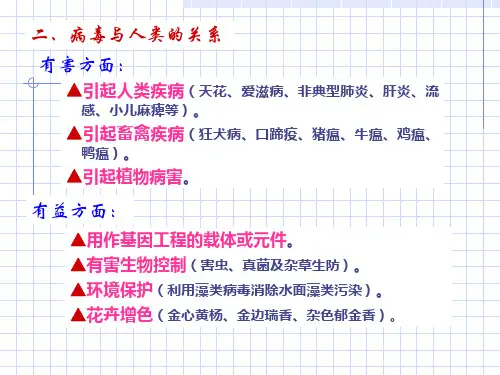
(4)单链DNA(ssDNA)
联体病毒科(Geminiviridae)病毒含有这种类型基因组,复制时单链 DNA先合成双链DNA,再以常规途径转录生成mRNA。
二、病毒与人类的关系
有害方面:
▲引起人类疾病(天花、爱滋病、非典型肺炎、肝炎、流 感、小儿麻痺等)。
▲引起畜禽疾病(狂犬病、口蹄疫、猪瘟、牛瘟、鸡瘟、 鸭瘟)。
▲引起植物病害。
有益方面:
▲用作基因工程的载体或元件。 ▲有害生物控制(害虫、真菌及杂草生防)。 ▲环境保护(利用藻类病毒消除水面藻类污染)。 ▲花卉增色(金心黄杨、金边瑞香、杂色郁金香)。
植物病毒的基因组多数为核糖核酸(RNA),少数为脱氧核糖核
酸(DNA)。根据核酸性质及功能,可将植物病毒基因组分为下列5 种类型:
(1)正单链RNA(+ssRNA)
单链RNA具有侵染性,可以直接翻译蛋白,起mRNA的作用。大 部分重要植物病毒的基因组属这一类型。占70%以上,如TMV, CMV,PVY;多分体病毒等。
2、对病毒本质的认识(病毒理化特性)
◆ 1935年,美国的斯坦利(Stanley)提纯TMV结晶,于1946年获诺贝 尔化学奖。
◆ 1936年,英国的鲍登(Bawden)发现TMV含有95%的蛋白质和5% 的RNA。
◆ 1939年,美国的凯奇(Kausche)获得第一张TMV电镜照片。 ◆ 1944年,美国的斯克诺定尔(Schrodinger)发表了“What is Life?”
(2)负单链RNA(-ssRNA)
病毒粒体中的单链RNA不具侵染性,必需先转录成互补链,才能 翻译蛋白。植物弹状病毒的基因组属这一类型。如小麦丛矮病毒。
(3)双链RNA(dsRNA)
植物基因沉默
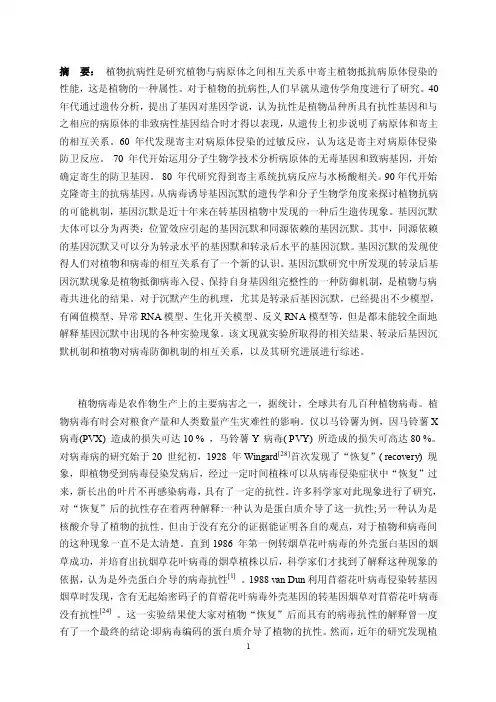
摘要:植物抗病性是研究植物与病原体之间相互关系中寄主植物抵抗病原体侵染的性能,这是植物的一种属性。
对于植物的抗病性,人们早就从遗传学角度进行了研究。
40 年代通过遗传分析,提出了基因对基因学说,认为抗性是植物品种所具有抗性基因和与之相应的病原体的非致病性基因结合时才得以表现,从遗传上初步说明了病原体和寄主的相互关系。
60 年代发现寄主对病原体侵染的过敏反应,认为这是寄主对病原体侵染防卫反应。
70 年代开始运用分子生物学技术分析病原体的无毒基因和致病基因,开始确定寄生的防卫基因。
80 年代研究得到寄主系统抗病反应与水杨酸相关。
90年代开始克隆寄主的抗病基因。
从病毒诱导基因沉默的遗传学和分子生物学角度来探讨植物抗病的可能机制,基因沉默是近十年来在转基因植物中发现的一种后生遗传现象。
基因沉默大体可以分为两类:位置效应引起的基因沉默和同源依赖的基因沉默。
其中,同源依赖的基因沉默又可以分为转录水平的基因默和转录后水平的基因沉默。
基因沉默的发现使得人们对植物和病毒的相互关系有了一个新的认识。
基因沉默研究中所发现的转录后基因沉默现象是植物抵御病毒入侵、保持自身基因组完整性的一种防御机制,是植物与病毒共进化的结果。
对于沉默产生的机理,尤其是转录后基因沉默,已经提出不少模型,有阈值模型、异常RNA模型、生化开关模型、反义RNA模型等,但是都未能较全面地解释基因沉默中出现的各种实验现象。
该文现就实验所取得的相关结果、转录后基因沉默机制和植物对病毒防御机制的相互关系,以及其研究进展进行综述。
植物病毒是农作物生产上的主要病害之一,据统计,全球共有几百种植物病毒。
植物病毒有时会对粮食产量和人类数量产生灾难性的影响。
仅以马铃薯为例,因马铃薯X 病毒(PVX) 造成的损失可达10 % ,马铃薯Y 病毒( PVY) 所造成的损失可高达80 %。
对病毒病的研究始于20 世纪初,1928 年Wingard[28]首次发现了“恢复”( recovery) 现象,即植物受到病毒侵染发病后,经过一定时间植株可以从病毒侵染症状中“恢复”过来,新长出的叶片不再感染病毒,具有了一定的抗性。
植物免疫(植物抗病机制)PPT课件
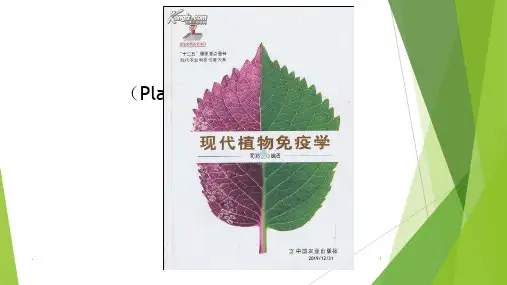
.
2019/12/31
4
喷施病毒蛋白使植物产生系统获得性抗性,从而能抵 抗多种病毒的入侵。
.
2019/12/31
5
RNA沉默(RNA silence)
双链RNA( dsRNA) 是基因沉默的关键起始因子, dsRNA 在生物体内被一个类 RNAase 称为Dicer 的酶降解为小分子干扰性RNA ( small interference RNA, siRNA) , siRNA 能够与RNAase 结合形成RNA 诱导的沉默复合体( RNA induced silencing complex, RISC) , 这一RISC 复合体能够特异性地攻击同源的mRNA 并使其降解。
植物的抗病性 (Plant disease resistance)
陈浩杰
.
2019/12/31
1
一、病原微生物对植物的危害
①水分平衡失调
病原微生物通过影响水分的吸收、运输与散失,进 而影响水分平衡。
②呼吸作用加强
一方面是病原微生物本身具有的强烈的呼吸作用, 另一方面是寄主呼吸速率加快。
③光合作用下降
.
2019/12/31
6
.
2019/12/31
7
参考文献
[1]王文娟等.植物抗病分子机制研究进展[J]生物技术通报,2007:19-24. [2]潘瑞炽等,植物生理学[M]北京:高等教育出版社,2012.7:340-343. [3]张艳秋等,植物系统获得性抗性研究进展[J]东北农业大学学报39(12): 113~117.
.
2019/12/31
8
.
2020
9
.
2019/12/31
10
植物免疫植物抗病机制6rna沉默rnasilence双链rnadsrna是基因沉默的关键起始因子dsrna在生物体内被一个类rnaase称为dicer的酶降解为小分子干扰性rnasmallinterferencernasirnasirna能够与rnaase结合形成rna诱导的沉默复合体rnainducedsilencingcomplexrisc这一risc复合体能够特异性地攻击同源的mrna并使其降解
VIGS 病毒诱导的基因沉默
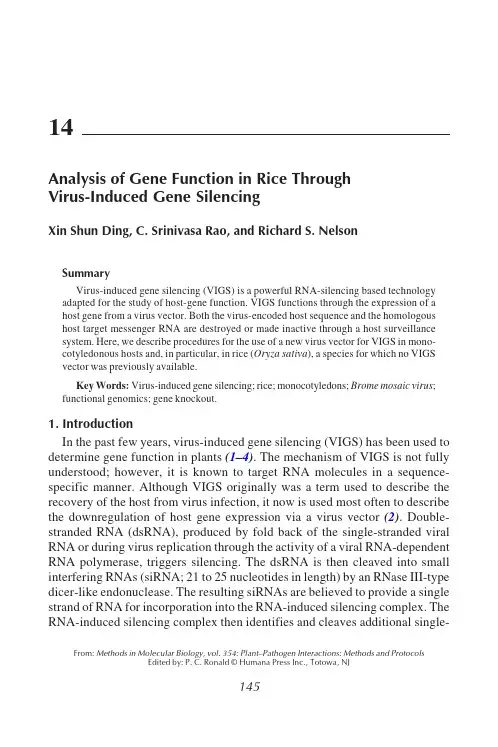
14Analysis of Gene Function in Rice ThroughV irus-Induced Gene SilencingXin Shun Ding, C. Srinivasa Rao, and Richard S. NelsonSummaryVirus-induced gene silencing (VIGS) is a powerful RNA-silencing based technology adapted for the study of host-gene function. VIGS functions through the expression of a host gene from a virus vector. Both the virus-encoded host sequence and the homologous host target messenger RNA are destroyed or made inactive through a host surveillance system. Here, we describe procedures for the use of a new virus vector for VIGS in mono-cotyledonous hosts and, in particular, in rice (Oryza sativa), a species for which no VIGS vector was previously available.Key Words: Virus-induced gene silencing; rice; monocotyledons; Brome mosaic virus;functional genomics; gene knockout.1. IntroductionIn the past few years, virus-induced gene silencing (VIGS) has been used to determine gene function in plants (1–4). The mechanism of VIGS is not fully understood; however, it is known to target RNA molecules in a sequence-specific manner. Although VIGS originally was a term used to describe the recovery of the host from virus infection, it now is used most often to describe the downregulation of host gene expression via a virus vector (2). Double-stranded RNA (dsRNA), produced by fold back of the single-stranded viral RNA or during virus replication through the activity of a viral RNA-dependent RNA polymerase, triggers silencing. The dsRNA is then cleaved into small interfering RNAs (siRNA; 21 to 25 nucleotides in length) by an RNase III-type dicer-like endonuclease. The resulting siRNAs are believed to provide a single strand of RNA for incorporation into the RNA-induced silencing complex. The RNA-induced silencing complex then identifies and cleaves additional single-From:Methods in Molecular Biology, vol. 354: Plant–Pathogen Interactions: Methods and ProtocolsEdited by: P. C. Ronald © Humana Press Inc., Totowa, NJ145stranded target RNA sequences complementary to the “captured” siRNA sequence(2,5,6). Of interest, cleavage of additional target RNA through this pathway may not be the only method of controlling virus accumulation. It is possible that small RNAs derived from viral single-stranded RNA stem-loops, similar in structure to the microRNAs derived from host RNAs, inhibit virus accumulation through translational repression (4). With time, the mechanism of VIGS will be determined, but this lack of basic information does not prevent its practical use to study gene function. To date, multiple RNA plant virus vectors (e.g. Tobacco mosaic virus,Potato virus X, and Tobacco rattle virus) are available for VIGS in dicotyledonous plant species and one RNA virus vector,Barley stripe mosaic virus, is available for VIGS in two monocotyle-donous species (barley and wheat [7–14]). Here, we review the use of a plant virus vector newly created from a strain of Brome mosaic virus (BMV), to silence genes in various monocotyledons, including rice, through VIGS.To construct this BMV vector, we isolated a virus from an infected Tall Fescue plant (Festuca arundinacea Schreb.) and purified viral RNA from the virus capsid (15,16). Previous analysis of the capsid, through electron microscopy, and viral RNA, through Northern blot analysis, indicated that this virus was a strain of BMV, which we named the fescue strain of BMV (F-BMV[15]; Ding, X. S. and Nelson, R. S., to be submitted). Full-length reverse transcription polymerase chain reaction (RT-PCR) products of the three viral genomic RNAs were synthesized, gel purified, and ligated individually into the pGEM T-Easy vector (Promega, Madison, WI). The ligation products were transformed individually into Escherichia coli JM109-competent cells. The plasmids containing the viral complementary DNAs (cDNAs) were named pF1-11, pF2-2, and pF3-5 (for F-BMV cDNA representing BMV genomic RNAs 1, 2, and 3, respectively [15a]). Three RNAs from the Russian strain of BMV (R-BMV [16]) also were cloned (pB1-26 for RNA1, pB2-4 for RNA2, and pB3-3 for RNA3) using the same technique as described for the F-BMV. We determined that the viral sequence necessary for infecting rice did not reside in RNA 3 of BMV [15a]). This information allowed us to use the clone repre-senting RNA 3 from R-BMV, which has a more convenient restriction site for inserting host sequences than does the cDNA representing F-BMV RNA 3, in our VIGS vector. Co-inoculation of rice plants with transcripts from pF1-11, pF2-2, and pB3-3 harboring a fragment of phytoene desaturase from maize (Zea mays) caused silencing of this gene in rice (15).VIGS has several advantages over other functional genomics approaches, such as no transformation of the host plant is required and the function of indi-vidual gene family members can be studied (2). An additional major advantage is the rapidity with which a researcher can observe a silencing phenotype during VIGS. A silencing phenotype can be observed within 3 wk after inserting ahost sequence into the BMV vector and inoculating plants. For important monocotyledonous crops such as rice and maize, for which no rapid gene knockout technology exists, VIGS with the F-BMV vector was effective in silencing genes (15a).This chapter provides procedures to execute the following:1.Insert plant sequences into bacterial plasmids and transfer them to the BMV vector.2.Synthesize the BMV vector transcripts.3.Inoculate plants with transcripts.4.Analyze virus infection and gene silencing in the plants.It is important that all plants inoculated with BMV or BMV harboring a foreign insert be kept inside a greenhouse or growth chambers. Infected plants and materials used to grow these plants (e.g., soil, pots, and trays) should be autoclaved before disposal to prevent release of the virus into the environ-ment, as per regulations from the US Department of Agriculture governing the use of pathogens and transgenic viral sequences.2. Materials2.1. Insertion of Foreign Sequences Into the BM V V ector1.pB3-3 (plasmid containing cDNA of R-BMV RNA 3; Fig. 1).2.pGEM–T Easy vector (Promega; Madison, WI).3.JM109 competent cells (108 cfu; Promega)., 4.SOC medium: tryptone 2% (w/v), 8.6 m M NaCl, 2.5 m M KCl, 20 m M MgSO420 m M glucose (Sigma; St. Louis, MO).5.2% X-gal (5-bromo-4-chloro-3-indolyl-E-D-galactoside): 20 mg in 1 mL ofdimethylformamide (Promega)O 6.20% Isopropyl-E-D-thio-galactopyranoside (IPTG), 200 mg in 1 mL of H2 (Promega)7.Luria broth (LB) medium: 25 LB medium capsules per liter of distilled HO2 (Q-BIOgene; Irvine, CA).O 8.LB agar medium: 16 LB agar medium capsules per 400 mL of distilled H2 (Q-BIOgene).9.LB liquid medium containing ampicillin (Sigma): autoclave LB liquid mediumat 121q C for 20 min in 1-L autoclavable bottle. Remove the bottle from the auto-clave after the pressure is fully released. Cool the medium to approx 50q C and add ampicillin (100 P g/mL medium; see Note 1). Mix well and store the medium at 4q C before use.11.LB medium plate containing ampicillin (Sigma): autoclave LB agar medium at121q C for 20 min. Remove the bottle from the autoclave after the pressure is fully released. Cool the medium to approx 50q C and add ampicillin (100 P g/mL medium). Mix well and pour the medium into 20 Petri dishes (100 u 15 mm; see Note 1). Store plates at 4q C before use.Fig. 1. Schematic drawing of pB3-3 showing restriction sites for inserting foreign deoxyribonucleic acid sequence or linearizing the plasmid before in vitro transcription.12.LB medium plate containing ampicillin, X-gal and IPTG: Mix 20 P L of 2%O with 50 P L of 20% IPTG. Spread the X-gal solution and 30 P L sterilized H2mix onto the surface of an LB medium plate containing ampicillin. Incubate the plate at 37q C for 1 h and then store the plate at 4q C before use (see Note 1).13.T4 DNA ligase with 10X buffer (NEB; Ipswich, MA).14.Nuclease-free water.15.1-kb DNA ladder (NEB).16.Hin dIII restriction enzyme with 10X reaction buffer (NEB).17.QIAquick PCR Purification kit (Qiagen; Valencia, CA).18.QIAquick Gel Extraction kit (Qiagen).19.Buffer P1 (Qiagen).20.Buffer P2 (Qiagen).2.2. Preparation of BM V RNA Transcripts and Inoculation of Plant1.BMV clones (pF1-11, pF2-2, pB3-3, and pB3-3 containing a plant gene sequence).2.Phenol/chloroform/IAA solution (Ambion; Austin, TX).3. 3 M Sodium acetate, pH 5.2.4.mMESSAGE mMACHINE T3 kit (Ambion).5.Spe I restriction enzyme with 10X buffer (NEB).6.PshA I restriction enzyme with 10X buffer (NEB).2.3. Analysis of V irus Infection and Gene Silencing in Plants1.Polyclonal antibody against BMV coat protein (see Note 2).2.Primers to allow specific detection of host insert sequence in virus genome, virusgenome, and host transcript targeted for silencing.3.SuperScript reverse transcriptase with 5X first strand buffer and 0.1 M dithiothrei-tol (DTT; Invitrogen, Carlsbad, CA).4.Taq DNA polymerase in buffer B with 10X PC R buffer and 25 m M MgC l2 (Promega).5.SUPERase In™ (Ambion).6.10 m M dNTP Mix: Mix 10 P L of 100 m M dATP, 10 P L of 100 m M dCTP, 10 P LO.of 100 m M dGTP, and 10 P L of 100 m M dTTP with 60 P L of nuclease-free H27.Recombinant RNasin (40 U/P L; Promega).8.TRIzol Reagent (Invitrogen).9.DNaseI (RNase free; Ambion).10.Chloroform.11.Isopropanol.12.Ethanol.13.Agarose (Shelton Scientific, Shelton, CA).14.Mortars and pestles: bake mortars and pestles at 180q C for 3 h before use.15.0.6-mL Microfuge tube (ISC Bioexpress, Kaysville, UT).3. Methods3.1. Insertion of Foreign Sequences Into the BM V V ectorTo silence a plant gene of interest through VIGS, DNA representing a portion of the gene should be inserted into the Hin dIII restriction site within the pB3-3 construct (Fig. 1). Inserts can be 150 to 250 nucleotides in length for this vector.A gene fragment is amplified from total cellular RNA isolated from plant tissue through RT-PCR using primers specific for the gene. The amplified gene frag-ment is then ligated into the T-Easy vector. After purifying the T-Easy vector containing the inserted host-gene fragment, the fragment is released through digestion with Hin dIII and gel purified. The gene fragment then is ligated into the pB3-3 vector predigested with Hin dIII.3.1.1. Synthesis and Ligation o f a Target Host-G ene FragmentInto T-Easy V ector1.Amplify a fragment (150 to 250 nucleotides in length) from a host mRNA represent-ing a gene of interest using specific primers under predetermined RT-PCR condi-tions (see Note 3). An approx 100-P L PCR reaction mix is needed for each fragment.2.Begin purifying the PCR product by mixing it with 500 P L of PB buffer (Qiagen;see Note 4).3.Load the mixed solution onto a QIAquick spin column inserted into a 2-mL col-lection tube. Spin the column-collection tube unit at 15,000g for 1 min and dis-card the flow-through.4.Add 0.7 mL of PE buffer (Qiagen) to the column and spin the column with acollection tube at 15,000g for 1 min. Discard the flow-through and spin the column with collection tube again at 15,000g for 1 min.5.Place the column into a clean 1.7-mL microfuge tube. Add 50 P L of EB buffer(Qiagen) to the column and spin the column-collection tube unit at 15,000g for 1 min.6.Concentrate the PCR product by spinning the tube in a microfuge under vacuumuntil the final volume of the PCR product is approx 5 P L.7.Set up a ligation reaction by mixing 3 P L of PCR product (approx 200 ng of DNA)with 0.5 P L of pGEM-T Easy Vector (50 ng), 5 P L of 2X ligation buffer, 1 P L ofO, and 1 P L of T4 DNA ligase (Promega) in a microfuge tube.nuclease-free H28.Mix the contents by flicking the tube several times. Spin the tube briefly tocollect the ligation mixture at the bottom of the tube and incubate the tube overnight at 4q C.3.1.2. Trans f ormation o f Competent E. coli Cells With Plasmid Containing the Host Se q uence1.Place JM 109 competent cells from –80q C freezer on ice until just thawed(5 to 10 min).2.Transfer 25 P L of just-thawed competent cells into a prechilled 14-mL Falcontube (Becton Dickinson, Franklin Lakes, NJ). Add 2 P L of ligation mixture into the tube and mix gently by flicking the tube several times (see Note 5).3.Incubate the tube on ice for 20 min and then subject the tube to a heat-shocktreatment by holding it in a 42q C water bath for 40 s followed by a 2-min incuba-tion on ice.4.Add 250 P L of SOC medium into the tube and incubate the tube in a 37q C shakerset at 150 rpm for 1 h.5.Plate 100 P L of transformed cell culture onto a LB medium plate containingampicillin, X-gal and IPTG (see Note 1). If a greater number of colonies are desired, spin the transformed competent cell culture at 1000g for 2 min, resus-pend the pellet in 100 P L of fresh LB liquid medium, and plate the cells on one LB medium plate containing ampicillin, X-gal, and IPTG.6.Incubate the plate overnight in a 37q C incubator. After incubation, pick two tothree white colonies from the plate with toothpicks and inoculate each colony to individual Falcon tubes containing 2.5 mL of LB liquid medium with ampicillin.7.Incubate the Falcon tubes in a 37q C shaker set at 250 rpm overnight.3.1.3. Isolation o f T-Easy V ector With Plant-G ene Insert1.Before isolating plasmid DNA from the overnight cell culture, take 0.5 mL of theovernight culture and mix with 0.5 mL of sterile 50% glycerol in a sterile 1.7-mL microfuge tube. Store the tube at –70q C for future use.2.Transfer 1.7 mL of the remaining overnight cell culture into a microfuge tube.Pellet cells by centrifuging the microfuge tube at 15,000g in a microfuge at room temperature (RT) for 5 min (see Note 6).3.Discard the supernatant. Resuspend the pellet in 0.3 mL of buffer P1 with RNaseA (Qiagen) by pipetting the cells up and down until the pellet is fully dissolved.Incubate the microfuge tube at RT for 5 min.4.Add 0.3 mL of lysis buffer P2 (Qiagen) into the microfuge tube and mix by inver-sion five or six times. Incubate the tube on ice for 5 min.5.Add 0.3 mL of 3 M potassium acetate, pH 5.5, to the microfuge tube and mix byinversion two to three times. Incubate the microfuge tube on ice for 10 min. 6.At RT, centrifuge the mixture at 15,000g for 10 min in a microfuge. Pour the super-natant into a clean microfuge tube and centrifuge again at 15,000g for 5 min.7.Pour the supernatant (approx 0.9 mL) into a clean microfuge tube. Add 0.65 mLof isopropanol into the microfuge tube, mix and incubate the mixture on ice for 20 min.8.At RT, centrifuge the mixture at 15,000g for 15 min to pellet plasmid DNA.Discard the supernatant. To wash the DNA, carefully add 0.7 mL of 75% ethanol to the tube, flicking the tube several times, and centrifuge the tube at 15,000g for 5 min.9.Carefully remove the supernatant without dislodging the DNA pellet. Dry theremaining pellet by centrifugation in a vacuum centrifuge (e.g., Savant SC110A, Cambridge Scientific Products, Cambridge, MA) for 5 min.10.Resuspend the pellet in 20 P L of nuclease-free H2O. Estimate the concentrationof the plasmid DNA preparation by electrophoresis in a 1% agarose gel contain-ing 0.1 P g of ethidium bromide per milliliter of agarose solution (see Note 7) and comparison with differing known concentrations of 1-kb DNA ladder loaded in adjacent lanes. Alternatively, determine the plasmid concentration with a spec-trophotometer.3.1.4. Trans f er o f Plant-G ene Se q uence From p G EM T-Easy to pB3-3 1.To release the plant-gene sequence from the T-Easy plasmid, mix 5 P L of thepurified T-Easy plasmid containing the plant sequence (approx 2 P g of DNA)with 3 P L of 10X Hin dIII reaction buffer (NEB), 21 P L of nuclease-free H2O and1.5P L of Hin dIII restriction enzyme (NEB) in a microfuge tube. Incubate thetube at 37q C for 2 h.2.After digestion, mix the DNA sample with a loading dye and load the sampleonto a 1% agarose gel containing 0.1 P g of ethidium bromide per milliliter of agarose solution. Electrophorese to separate the DNA fragment containing the plant gene sequence from the T-Easy vector DNA. Also load a DNA ladder as a size marker.3.Visualize DNA bands with an ultraviolet transilluminator. Excise the gel frag-ment containing the plant gene sequence using a clean razor blade and transfer the gel slice into a microfuge tube (approx 300 P g of gel slice per tube).4.Add 1 mL of QG buffer (Qiagen; see Note 8) to the microfuge tube and incubateat 50q C for 10 min. Invert the tube several times during the incubation. The gel slice should be completely dissolved before moving to the next step.5.Place a QIAquick spin column into a 2-mL collection tube. Add 0.75 mL of dis-solved gel solution into the column. Centrifuge the column and collection tube unit in a microfuge at 15,000g and RT for 1 min.6.Discard the flow-through and place the column back onto the same collectiontube. Add the remaining gel solution onto the column and then centrifuge the column-collection tube unit at 15,000g and RT for 1 min.7.Discard the flow-through, re-attach the collection tube, and add 0.75 mL of freshQG buffer to the column. Centrifuge the column-collection tube unit at 15,000g and RT for 1 min.8.Wash the column by adding 0.75 mL of PE buffer (Qiagen; see Note 8) and centri-fuge the column and collection tube at 15,000g for 1 min. Discard the flow-through and spin the column-collection tube unit again at 15,000g for an additional minute, discarding the flow-through.9.Place the column above a clean 1.7-mL microfuge tube. Add 50 P L of nucleotide-O or EB Buffer (Qiagen; see Note 8) to the column and centrifuge the free H2column-collection tube unit at 15,000g for 1 min. Concentrate the purified DNA fragment by centrifuging the collection tube under vacuum for 20 min or until the final volume of the DNA sample is approx 5 P L.10.To ligate the purified DNA fragment containing the host gene sequence intopB3-3, set up a ligation reaction by mixing 3 P L of the gel-purified DNA fragment (approx 200 ng), 1 P L of pB3-3 vector linearized with Hin dIII enzyme (approx 100 ng), 5 P L of 2X ligation buffer, and 1 P L of T4 DNA ligase (Promega) in a0.7-mL microfuge tube.11.Mix the reagents by flicking the tube several times. Centrifuge the tube brieflyto collect the reaction mixture in the bottom of the tube and incubate overnight at 4q C.12.Transform JM109 competent cells with the ligation product and isolate pB3-3containing the plant gene sequence from the transformed cells as described in the Subheading 3.1.2.3.2. Synthesis of BM V RNA Transcripts and Plant InoculationBefore in vitro transcription, the three plasmids containing the BMV genome sequences should be linearized using Spe I (pF1-11) or PshA I (pF2-2 and pB3-3) restriction enzymes. RNA transcripts representing the three BMV genomic RNAs are prepared individually from the linearized plasmids in vitro and the products mixed before inoculating host plants. RNA transcripts can be stored at –70q C before use. All reagents and materials used during the in vitro transcription reactions should be nuclease-free.3.2.1. Synthesis o f RNA Transcripts1.Linearize pF1-11, pF2-2, and pB3-3 individually in 50-P L reactions contain-ing 2 P g of template DNA, 5 P L of 10X the restriction enzyme buffer, 0.5 P L of bovine serum albumin (100 mg/mL), and 1.5 P L of Spe I (pF1-11) or 1.5 P L ofPshA I (pF2-2, pB3-3, and pB3-3 with insert) restriction enzymes. Incubate the reactions at 37q C for 1.5 h.2.After incubation, add 50 P L of a phenol/chloroform/IAA solution to eachmicrofuge tube (see Note 9). Mix the content thoroughly by vortexing the microfuge tubes for 20 s and then centrifuge at 15,000g and RT for 5 min.3.Transfer the upper liquid phase (approx 50 P L) from each tube into a cleannuclease-free microfuge tube.4.Add 50 P L of chloroform to each microfuge tube. Mix the contents thoroughly byvortexing the microfuge tubes for 15 s and then centrifuging the tubes at 15,000g for 5 min.5.Transfer the upper liquid phase (approx 50 P L) from each tube into a cleannuclease-free microfuge tube. Add 5 P L of 3 M sodium acetate, pH 5.2, and 100P L of ice-cold ethanol to each tube. Mix the content by flicking the tubes several times. Incubate the tubes at –20q C for 1 h or at –70q C for 20 min.6.Centrifuge the microfuge tubes at 15,000g for 15 min and discard the supernatant.7.Add 0.7 mL of ice-cold 70% ethanol to each tube. Flick the tubes several timesand centrifuge them at 15,000g and RT for 5 min.8.Discard the supernatant from each tube. Dry the pellets in a vacuum centrifugefor 5 min.O. Visualize the efficiency of 9.Resuspend each pellet in 15 P L of nuclease-free H2the linearization and estimate the concentration of each linearized template by electrophoresis through a 1% agarose gel containing 0.1 P g of ethidium bromide per milliliter of agarose solution. An aliquot of 1-kb DNA ladder containing a fragment of known concentration should be loaded on the gel to aid in determin-ing the amount of product produced and the efficiency of the reaction.Transcripts from the individual linearized templates are synthesized by adding 10P L of 2X NTP/CAP solution, 2 P L of 10X reaction buffer (both from mMessage mMachine kit, Ambion) and 6 P L of template DNA (approx 0.5 P g, representing BMV RNA 1, 2, or 3) into a nuclease-free microfuge tube.10.The in vitro transcription reaction is initiated by adding 2 P L of T3 enzyme mixinto each tube, mixing well by flicking the tubes several times and incubating tubes at 37q C for 1.5 h.11.The product RNA transcripts can be used to infect a plant immediately, or storedat –70q C for later use.3.2.2. Inoculation o f Plant With TranscriptBMV RNA transcripts can be used to infect seedlings directly through mechanical inoculation. To achieve more successful infections, the viral transcripts should be inoculated first to Nicotiana benthamiana seedlings; this plant is easily infected and allows high titers of many viruses to accumulate in its leaves. Crude extracts from N. benthamiana leaves are then used to infect rice seedlings.1.Seeds of N. benthamiana are sown in a soil mixture (Metromix 350; SunGroHorticulture, Bellevue, WA) in small pots. At 3 wk after planting, individualseedlings are transplanted into 4.5-in. pots. Seeds of rice are planted directly intoa soil in 4.5-in. pots. Rice is particularly intolerant of suboptimal soil conditions.Greenhouse temperatures for N. benthamiana and rice are 25/20q C (day/night).Seedlings are watered and fertilized as needed.2.Mix in vitro transcripts representing BMV RNAs 1, 2, and RNA 3, harboring ornot harboring a host-gene insert. Select two similar sized N. benthamiana seed-lings at 5 d after transplanting. Dust two leaves of each plant with Carborundum (320 grit; Sigma) through cheesecloth layers and inoculate the leaves by gently rubbing 7.5 P L of mixed transcripts across the surface of each leaf. The inoculated plants are then moved to a growth chamber at 24/20q C (day/night). As controls, leaves of two N. benthamiana seedlings are inoculated with mixed transcripts representing BMV RNAs 1, 2, and 3, without the host-gene insert.3.Monitor virus levels and stability of the plant target sequence in the virus in eachinoculated N. benthamiana plant by immunocapture RT-PCR (IC) using primers specific for BMV RNA3 sequences as described in Heading 3.4.Harvest leaf tissue from infected N. benthamiana plants, grind the tissue in 0.1 Mphosphate buffer, pH 6.5 (1:10, w/v) at 4q C.5.Dust leaves of 2-wk-old rice seedlings with Carborundum and inoculate them withthe crude extracts prepared from the infected N. benthamiana leaves in step 4.The inoculated rice seedlings are grown in a greenhouse at 25/20q C (day/night) and monitored for virus infection and gene silencing through symptom observa-tion, IC RT-PCR and semiquantitative RT-PCR described in Heading 3.3.3. Analysis of V irus Infection and Gene Silencing in PlantThe progress of infection by the BMV vector in the host can be monitored through IC RT-PCR. The stability of the plant-gene insert in the virus vector during systemic infection of the host can also be monitored using this technique.3.3.1. Detection o f V irus Through IC RT-PCRThis procedure involves the capture of BMV virions from crude plant extracts on walls of microfuge tubes precoated with an antibody specific for the BMV coat protein (CP). Reverse transcription reactions can then be performed in the same microfuge tube without the need to release viral RNA from the bound virions. The resulting first strand cDNAs are then amplified via PCR using primers specific to the BMV RNA 3 sequence.1.Dilute 1 P L of BMV CP antibody (15) in2.5 mL of coating buffer (coating buffer:1.59 g Na2CO3and 2.93 g NaHC O3to 1 L distilled H2O. Adjust pH to 9.6with HCl).2.Add 30 P L of diluted antibody solution to each 0.6-mL microfuge tube (ISCBioexpress) and incubate the tubes overnight at 4q C.3.Wash each tube twice using 0.1 M phosphate buffer (PB), pH 7.0. After removingPB from the tubes, store them at –20q C for later use.4.Collect two leaf discs by pressing leaf with the lid of a microfuge tube (approx100 mg total) from each plant and grind them inside the microfuge tube in 100 P L of 0.1 M PB with disposable plastic pestles at RT.5.Add 30 P L of crude leaf extract from each sample to a 0.6-mL tube pre-coatedwith the CP antibody and incubate the tube overnight at 4q C.6.Wash each tube three times with 0.1 M PB.7.Add 5 P L of solution containing a primer complementary to the 3' end of the BMVRNA 3 sequence (0.5 P L of 10 m M reverse primer in 4.5 P L of DEPC H2O) to eachtube and incubate the tubes at 70q C for 10 min followed by 2 min on ice.8.Add 5.0 P L of premixed RT reagents (2 P L of 5X first-strand buffer, 1 P Lof 0.1 M DTT, 0.5 P L of 10 m M dNTP Mix, 0.5 P L of RNasin, 0.5 P L of SuperScript RT, and 0.5 P L of nuclease-free H2O) to each tube and incubate at 42q Cfor 1 h.9.After 1 h, add 1 to 2 P L of RT reaction mix to a PCR tube containing 18.5 P L ofmixed PCR reagents (2 P L of 10X PCR buffer, 2 P L of 25 m M MgCl, 0.5 P L of 10P M forward primer (specific for the BMV CP gene sequence), 0.5 P L of 10 P M reverse primer, 0.4 P L of 10 m M dNTPs, 0.1 P L of Taq polymerase, 14.5 P Lof nuclease-free H2O).10.Perform 30 cycles of PCR under predetermined conditions.11.Analyze PCR products on a 1% agarose gel containing 0.1 P g of ethidium bro-mide per milliliter of agarose solution. Some quantitation of virus accumulation can be achieved by decreasing the number of PCR cycles so the system is not saturated. Products from BMV vectors maintaining the host-gene insert should yield a higher-molecular-weight fragment than that observed from the BMV vector with no host insert (Fig. 2).3.3.2. Analysis o f Target-G ene Silencing Through Semi q uantitative RT-PCRThe level of plant-target-transcript silencing can be monitored through semiquantitative RT-PCR. The procedure described in this section uses prim-ers specific for the target gene, complementary or identical to sequences out-side the region of the gene expressed within the virus vector, and the gene encoding elongation factor-1D, as an internal control (other host mRNAs may serve as internal controls; the best are those whose levels do not fluctuate dur-ing virus infection). Relative transcript levels for the gene of interest between various treatments are estimated by comparing the intensity of PCR product gel bands obtained after multiple PC R cycle numbers and normalizing the intensities according to estimates of the substrate RNA levels based on results from the internal control.3.3.2.1. I SOLATION OF T OTAL RNA F ROM L EAF T ISS U ES1.Harvest leaf tissue from plants infected with the BMV vector containing or notcontaining the plant gene insert at 2 to 3 wk after inoculation. The harvested tissue can be used for RNA isolation immediately or stored at –70q C for future use.。
《基因沉默》课件
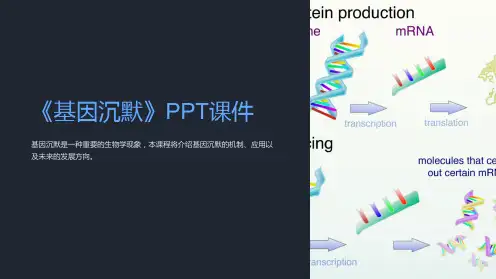
2
miRNA和siRNA的区别
miRNA和siRNA是两种不同的RNA分子,它们在RNA干扰机制中扮演着不同的 角色。
3
RNA干扰的作用
RNA干扰可以调节基因表达,对细胞的功能和生理过程产生重要影响。
基因沉默的应用
疾病治疗
基因沉默在疾病治疗中可以 作为一种新的治疗策略,为 患者提供希望。Fra bibliotek农业应用
基因沉默技术可以用于提高 农作物的产量和抗性,改善 农业可持续发展。
《基因沉默》PPT课件
基因沉默是一种重要的生物学现象,本课程将介绍基因沉默的机制、应用以 及未来的发展方向。
引言
基因沉默是指通过不同机制抑制基因表达的过程。了解基因沉默对于疾病治 疗和科学研究具有重要意义。
RNA干扰机制
1
RNA干扰基本原理
通过RNA干扰,细胞可以通过RNA分子的介入,抑制特定基因的表达。
基因沉默未来发展方向
1
未来的趋势和挑战
基因沉默领域仍面临许多挑战,如副作用和技术难题,但也有许多发展机会。
2
基因沉默的新应用
基因沉默技术可能在癌症治疗、基因治疗等领域中发展出新的应用。
结论
基因沉默在生物研究和应用中的重要性
基因沉默为疾病治疗、农业发展和科学研究提供了新的思路和工具。
未来的发展前景
随着技术的进步和新的应用的发现,基因沉默将继续展现其巨大的潜力。
科研应用
基因沉默为科学研究提供了 一种重要工具,有助于我们 更好地理解基因功能。
基因沉默的研究方法
RNAi技术
RNA干扰技术是一种常用的方 法,通过介入RNA的存在来实 现基因沉默。
克隆基因敲除技术
通过将特定基因从细胞中彻底 去除,探索该基因在细胞和生 物体中的功能。
植物抗病毒的可能机制-基因沉默
植物抗病毒的可能机制——基因沉默植物抗病性是植物抵抗病原物侵染的性能。
1986年有人首次将烟草花叶病毒(TMV,下称)的衣壳蛋白(CP,下称)基因导人烟草获得了抗TMV转基因植株后,很多学者开展了转基因抗病毒的研究。
1990年Carylon等人首先报道了转基因沉默(Transgene silencing)现象。
基因沉默是指生物体中特定基因由于种种原因不表达。
它发生在两种水平上,1种是转录水平上的基因沉默,另1种是转录后基因沉默(post transcriptional gene silencing.PTGS.下称)。
转录后水平基因沉默在植物表现型上称为共抑制,是指在外源基因沉默的同时,与其同源的内源基因的表达也受到抑制的现象。
Carylon为加深花色将查尔酮合成酶基因(ehalcone synthase,CHS)转到紫花矮牵牛中,发现42%的转基因植株中不仅花色未加深,反而变为白色或紫白相间,这种转入的外源基因和内源基因共同沉默的现象就是转基因沉默。
目前认为.植物基因沉默是植物长期进化形成的用来防止外来遗传物质干扰自身基因组功能和保持稳定性的重要机制,是生物体中1种不完全的原始的生物免疫系统。
本文将从基因沉默的角度介绍植物抗病毒的可能机制。
1 RNA介导的病毒抗性和PTGS近20年来,植物抗病毒基因工程的研究逐步深入。
在CP基因介导的抗性研究中,对CP基因进行改造,插入翻译终止密码子或去掉翻译起始密码子,使其不能翻译产生CP蛋白,结果也能获得高抗病甚至免疫的转基因植株。
这种病原来源的抗性称之为RNA介导的病毒抗性(RNA mediated virus re— sistance,RMVR.下称)。
RMVR与PTGS机制类似。
两者均发生在胞质中。
PTGS与RMVR两种现象具有许多共同特征,如序列特异性、与转基因的拷贝数有关,减数分裂后沉默保持的不可预见性(George,1998),所以RMVR也是1种PTGS。
植物生物技术-病毒诱导的基因沉默
设计合理的实验对
照
❖对于每个 VIGS 实验,都必须要有合适的对 照 来监控沉默的效果。阳性对照通常采用八 氢番 茄红素脱氢酶 (phytoene desaturase , PDS) 基因的沉默,因为 PDS 沉默能引起沉默区域发生光漂白,并迅 速产生 可见的表型 (Kumagai 1995) 。实 验中,为 了说明病毒自身是否会引起表型, 还必须用空 病毒载体接种植物作为阴性对照 。另一方面, 阴性对照也可以显示接种技术 对植物生长的影 响。
virus,TMV) 、马铃薯 X 病毒 (potato virus X , PVX) 、 番茄金色花叶病毒 (tomato golden mosaic virus , TGMV) 、烟草脆裂病毒 (tobacco rattle virus , TRV) 、卫星病毒 诱导的沉默 系 统 (satellitevirusinducedsilencing ystem , SVISS) 、大 麦条状花叶病毒 (barley stripe osaic virus , BSMV) 、甘 蓝缩叶病毒 (cabbage leaf
VIGS: virus- induced gene silencing
VIGS : virus- induced gene silencing
是一种转录后基因沉默现像,可引起内源
mRNA 特异性降解。
在 病 毒 载体 中 插入 目 标基 因 片 段 , 侵染寄主后,植 物 会表 现出 目 标基 因 功 能 丧失 或 表 达水 平下降的表型
1 ∶1混合 , 室温下放置 3 h 。选取 4 ~ 5 叶龄 的烟草小苗 , 将混合菌液用不带针头的 2 mL 注射器从背面注射渗入烟草叶片 , 使菌液充 满 整个叶片 , 每棵苗注射 2 片叶子。每个基 因每 次注射 12 株烟草 , 5 次重复。
《RNAi与基因沉默》课件
在1990年代初期,科学家们发现双链RNA可以诱导基因沉默,但具体的机制和作用方式并不清楚。随着研究的 深入,人们逐渐揭示了RNAi的分子机制和生物学意义。在1998年,Andrew Fire和Craig Mello因为发现了 RNAi机制而获得了诺贝尔生理学或医学奖。
RNAi作用机制
总结词
RNAi过程中可能产生脱靶效应,影响实验 结果的准确性和可靠性。
体内应用难度
在体内应用RNAi技术时,面临如何将 siRNA有效递送到靶细胞的问题。
细胞毒性
某些RNAi分子可能对细胞产生毒性,影响 实验结果。
伦理和法规问题
在人类和动物实验中,需要考虑伦理和法规 问题,确保实验的合法性和道德性。
未来研究方向与展望
基因沉默与疾病
基因沉默与许多疾病的发生和发展密切相关。例如,肿瘤、神经退行性疾病和遗传性疾病等许多疾病都 涉及到基因沉默现象。因此,深入了解基因沉默的机制可以为这些疾病的治疗和预防提04
关系
RNAi在基因沉默中的作用
基因沉默的触发机制
RNAi通过降解目标mRNA或抑制其 翻译,在转录后水平上调节基因表达 ,从而触发基因沉默。
发展新型RNAi技术
针对现有技术的不足,发展更高效、 低毒、特异的RNAi技术。
拓展应用领域
将RNAi技术应用于更多领域,如神 经科学、免疫学等。
深入研究作用机制
深入探究RNAi的作用机制,为技术 的改进和应用提供理论支持。
加强法规监管
制定和完善相关法规和伦理规范,确 保RNAi技术的合理应用和健康发展 。
RNAi的作用机制是通过双链RNA诱导特异性mRNA的降解来实现基因沉默的。在细胞 内,dsRNA被切割成小干扰RNA(siRNA),这些siRNA与mRNA结合并诱导其降解
病毒诱导的植物基因沉默详解
病毒诱导的植物基因沉默详解上个世纪20年代,科学家发现植物与病毒之间存在交叉保护现象:被病毒侵染后的植物可能产生对该病毒株系和相近株系的抗性。
但这种抗性也可能存在“恢复”的现象。
直到上世纪90年代,这些现象的产生机制才被逐渐阐释清楚:是由于病毒基因发生了转录后基因沉默而致使表达受到抑制的结果。
这种现象因此被称为“病毒诱导的基因沉默(virus-induced gene silencing, VIGS)”。
基于这种机制的启发,人们尝试将植物基因片段插入到病毒载体z 中,侵染植物达到实现基因表达的抑制。
经过多年的研究与发展,该技术已经逐渐成熟,并广泛用于植物基因功能研究和植物遗传改良应用。
图1.诱导的植物基因沉默实例。
VIGS的作用机制VIGS的作用机制与另一种常用的基因沉默技术——RNA干扰(RNAi)有很多相似之处。
相较于RNAi,基因沉默具有快速、高效、通量高等优点。
VIGS是利用携带目的基因的cDNA 片段的病毒载体侵染植物,病毒在植物体内的复制和转录能特异性诱导和插入片段序列同源的mRNA降解或者诱导其被甲基化等修饰,导致其不能正常翻译,从而引起植物表型或者指标发生变化。
具体地,病毒在植物体内的复制和表达过程中会形成双链RNA(double-strandedRNA, dsRNA)。
dsRNA首先被Dicer类似物(DCL,如DCL4)的RNase-III家族特异性核酸内切酶切割成小分子干扰RNA(small interfering RNA, siRNA)。
siRNAs进一步扩增,并以单链形式与Argonatute(AGO)RNA结合蛋白和RNase结合形成RNA诱导的沉默复合体(RNA-inducedsilencingplex,RISC)。
RISC能与同源RNA特异性互补结合,导致同源mRNA降解,发生转录后水平的基因沉默。
或者,RISC能与细胞核内的同源DNA相互作用导致其被甲基化修饰,发生转录水平的基因沉默。
- 1、下载文档前请自行甄别文档内容的完整性,平台不提供额外的编辑、内容补充、找答案等附加服务。
- 2、"仅部分预览"的文档,不可在线预览部分如存在完整性等问题,可反馈申请退款(可完整预览的文档不适用该条件!)。
- 3、如文档侵犯您的权益,请联系客服反馈,我们会尽快为您处理(人工客服工作时间:9:00-18:30)。
VIGS应用的病毒和载体
烟草:烟草花叶病毒TMV
大麦:大麦条纹花叶病毒barley stripe mosaic virus
拟南芥:卷心菜曲叶病毒 cabbage leaf curl virus
番茄:烟草脆裂病毒tobacco rattle virus (TRV)
马铃薯:Potato virusX(PVX)
9
10
2019/10/25
植物转化:农杆菌注射法agro-inoculation
转化pCAPE1、pCAPE2-GFP保存的农杆菌液分别用 含有50ng/μL卡那霉素和100ng/μL利福平的LB 液体培养基培养过夜。
培养到OD=1.2-1.5时,取菌液加入到1.5mL离心 管中,离心,用含10mMNaCl、0.1mM乙酰丁香酮、 1.75mMCaCl2的培养基重悬,静置90min。
7
Hale Waihona Puke 实验目的 构建适合不同植物(豆科)的VIGS载体
选用的病毒:Pea early browning virus (PEBV)
原因:1、与TRV同属 2、已建成带有GFP报告基因的表达载体
8
结果1、PEBV侵染克隆的构建
双元载体系统(binary vector system) 农杆菌介导的植物转化机理 本实验用的载体的构建 植物转化:农杆菌注射法(agro-inoculation)
可靠性为应用作高通量研究打下基础。
N. benthamiana中 PVX 、TRV 载体引起的突
变4周后又恢复现象,导致沉默与回复表型共 存,相比之下PEBV引起的现象稳定。
17
18
19
2019/10/25
两种转化质粒的农杆菌等量混合。
注射植物。嫩叶用1mL注射器在远轴端挑叶背,
11
但不挑破,吸取制备好的菌液注射。
检测转化体系
12
21天后,在注射 叶子上面新长出 来的叶子上检测 到绿色荧光
说明转化体系成 功。
结果2、八氢番茄红素去饱和酶基因(PDS) 的沉默
PDS是产生类胡萝卜素的关键基因,沉默后产
4
原理
RNAi 病毒复制过程中形成的双链RNA触发植物中
与之具有高度序列一致性的mRNA降解。 Dicer酶
5
优点:1、试验周期短 2、可以研究T-DNA标记的敲除突变体
和表达了沉默诱导基因的转化子中有致死表型 的基因 缺点:1、不易获得针对特异物种的病毒载体
2、感病表型可能与靶基因沉默表型混淆
生光漂白现象
PsPDS:P. sativum中的PDS基因
13
14
现象
15
RT-PCR检测PDS mRNA水平的变化
16
讨论
最广泛应用的病毒是PVX TRV VIGS应用还主要用于烟草。说明烟草感染效率
高,发展针对其它寄主的PEBV载体的难度。 农杆菌注射法的感染效率可达100%其高效性、
植物中病毒诱导的基因沉默
刘同坤
1
VIGS病毒诱导基因沉默 VIGS病毒诱导基因沉默
2
植物病毒可用作蛋白质过表达和序 列特异的基因沉默的表达载体,两者 都是功能基因组学研究工具.
3
病毒诱导的基因沉默(VIGS)的获得
1.构建载体 目的基因替换病毒中的与病毒复制、运动无关
的基因 直接插入到病毒基因组中 2 植物的转化 农杆菌 3 病毒携带目的基因在植物中复制和传播
